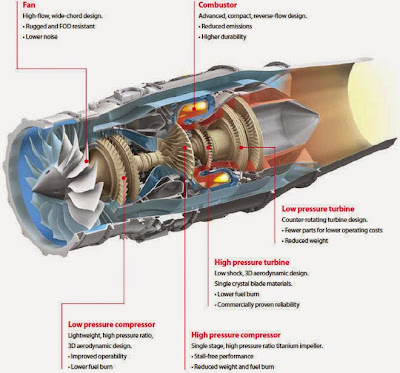The GE Honda HF120 turbofan engine that power's the new HondaJet light business jet, represents GE’s return to the business jet spa...
The GE Honda HF120 turbofan engine that power's the new HondaJet light business jet, represents GE’s return to the business jet space – a market the company helped create in the 1960s. At the time, GE engineers converted the J85 military jet engine into the CJ610 turbojet to power the first Learjet 23 business jet developed by the legendary aircraft designer Bill Lear.
Based on the Honda HF118 engine, GE and Honda engineers developed and certified the HF120 over the last decade. With 18.5 inches in diameter and 2,095 pounds of thrusts, the HF120 is the smallest in GE’s portfolio. By comparison, the largest GE jet engine, the GE9X under development to power the Boeing 777X, has a fan diameter of 132 inches and projected thrust above 100,000 pounds.
The engine weighing around 400 pounds has a thrust to weight ratio of 4.5:1.
The HondaJet is the car maker’s first entry into the aircraft business. Honda describes the plane, which can seat four passengers in a classic club configuration plus one in an optional side-facing fifth seat, as the world’s most advanced light business jet. HondaJet was designed in Japan and then developed and manufactured in Greensboro, North Carolina in the United States.
The HF120 incorporates a number of advanced features, including a high-temperature titanium impeller in the compressor for maximum engine pressure ratio and stall-free performance, a swept front fan “blisk” and composite outlet guide vanes, a compact reverse-flow configuration combustor and single-stage air-blast fuel nozzles, advanced materials in the high-pressure (HP) turbine as well as a two-stage low-pressure (LP) turbine and a counter rotating HP and LP spool shaft system.
In addition, the HF120 will require significantly less scheduled maintenance, with time between overhaul (TBO) of 5,000 hours and no need to open the engine for interim hot-section inspections. Compared to the competition, the HF120 is expected to stay on-wing 40% longer than typical business jet engines.
The HF120 is the first engine developed by GE Honda Aero Engines, formed by GE and Honda in 2004, based in Cincinnati, Ohio. The HF120 engine program was launched in 2006 to power the HondaJet.
To date, the HF120 program has accumulated close to 23,000 cycles and more than 13,000 hours demonstrating maturity prior to entering service in early 2015.
The HF120 achieved U.S. Federal Aviation Administration (FAA) Part 33 certification in December 2013. GHAE has submitted all required documentation for EASA certification, which is planned for the fourth quarter of 2015.
In 2014, Sierra Industries of Uvalde, Texas, selected the HF120 to develop a new Citation Jet engine retrofit program called the Sapphire aircraft.
The HF120 is mounted on the HondaJet in a unique over-the-wing engine mount (OTWEM) configuration which the Honda claims to reduce aerodynamic drag, thereby improving performance and fuel efficiency, and maximize the cabin space.
The Hondajet has began its European debut following completing the Japanese tour.
Based on a gereports.com article.
Based on the Honda HF118 engine, GE and Honda engineers developed and certified the HF120 over the last decade. With 18.5 inches in diameter and 2,095 pounds of thrusts, the HF120 is the smallest in GE’s portfolio. By comparison, the largest GE jet engine, the GE9X under development to power the Boeing 777X, has a fan diameter of 132 inches and projected thrust above 100,000 pounds.
The engine weighing around 400 pounds has a thrust to weight ratio of 4.5:1.
The HondaJet is the car maker’s first entry into the aircraft business. Honda describes the plane, which can seat four passengers in a classic club configuration plus one in an optional side-facing fifth seat, as the world’s most advanced light business jet. HondaJet was designed in Japan and then developed and manufactured in Greensboro, North Carolina in the United States.
 |
In addition, the HF120 will require significantly less scheduled maintenance, with time between overhaul (TBO) of 5,000 hours and no need to open the engine for interim hot-section inspections. Compared to the competition, the HF120 is expected to stay on-wing 40% longer than typical business jet engines.
The HF120 is the first engine developed by GE Honda Aero Engines, formed by GE and Honda in 2004, based in Cincinnati, Ohio. The HF120 engine program was launched in 2006 to power the HondaJet.
To date, the HF120 program has accumulated close to 23,000 cycles and more than 13,000 hours demonstrating maturity prior to entering service in early 2015.
The HF120 achieved U.S. Federal Aviation Administration (FAA) Part 33 certification in December 2013. GHAE has submitted all required documentation for EASA certification, which is planned for the fourth quarter of 2015.
In 2014, Sierra Industries of Uvalde, Texas, selected the HF120 to develop a new Citation Jet engine retrofit program called the Sapphire aircraft.
The HF120 is mounted on the HondaJet in a unique over-the-wing engine mount (OTWEM) configuration which the Honda claims to reduce aerodynamic drag, thereby improving performance and fuel efficiency, and maximize the cabin space.
The Hondajet has began its European debut following completing the Japanese tour.
Based on a gereports.com article.











